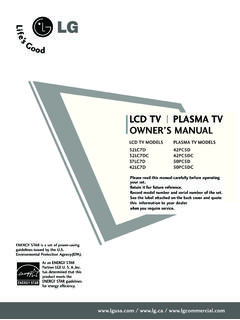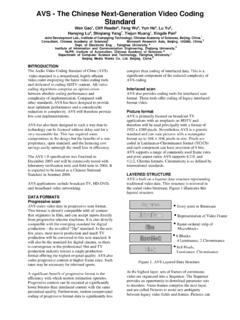Transcription of 60 Market focus: LEDs Hopes for mini-/micro-LED display ...
1 The world is awash withliquid-crystal displays(LCDs) from tiny indicator panels, throughmobile phones, up to giant television screens. Most LCDs,particularly those with colorcapabilities, incorporate a backlight that now consists oflight-emitting diodes (LEDs). In operation, the LCD part ofthe screen blocks or transmitslight to give an image. While LEDs have reducedpower consumption comparedwith the previous system based on fluorescent tech-nology, much of the light that is produced is wasted a black screen consumes as much power as white. This is a problem both for the giant TVs and for mobiledevices, where energy consumption reduces batterycharge. Developers of micro-LEDs plan to give every pixel an independent light-emitting source, cutting the backlight waste the power consumption of futuremicro-LED displays is estimated at 10% that of , this principle is used in large outdoor displayswith arrays of regular-size LED devices, but close-rangedisplays TVs, smartphones, etc need LEDs are of the order (500 m).
2 Reducing the size to about a fifth gives 100 m mini-LEDs,which find application in ultra-fine pixel-pitch displaysfor control rooms and indoor panels use arrays of individual red-green-blue(RGB) devices of less than 30 m, and even down m. Panels with micro-LEDs should be able to meetresolutions of 2000 6000 pixels-per-inch (ppi), muchhigher than the 400ppi used in retina LCD from cutting the backlight waste, LED-baseddisplays are competing with organic LEDs (OLEDs),which have been in development for a couple ofdecades. The promise of inorganic LEDs is reduced power con-sumption along with higher brightness and contrast,even compared with OLEDs. Power consumption ofmicro-LED displays is expected to be 50% that ofOLEDs. Micro-LED development is aimed at improvingthe quality and uniformity of epitaxial wafers neededfor high yield and low cost.
3 Further hoped-for advantages include ultra-high resolution, high color saturation, quick response andlong lifespan (Table 1).The adoption of micro-LED technology depends oncosts being closer to LCD panels than OLED panels $12 15 for a LCD compared with $65 70 foran active-matrix OLED display as used in the iPhone costs for micro-LED panels are projected tobe reduced significantly by 2021. Meanwhile, Japan sYano Research Institute expects the global micro-LEDmarket to increase from $7m this year to $224m in2020. In addition to offering a performance target, OLED salso stand as a warning to crystal-ball gazers. Many inthe industry, including Samsung (2006), expected thetechnology to replace LCDs as the mainstream displaytechnology. OLEDs were expected to deliver low powerconsumption, simple structure, wide color gamut,large viewing angles under sunlight, and quickresponse time, in a compact format.
4 OLED panels do consume less power, but they havealso not realized early expectations in this regard, withsavings falling below the original Hopes by about 30%.Another problem is that manufacturing processesusing organic materials have low yields for the highestperformance, increasing costs. Market focus: LEDs semiconductorTODAYC ompounds&AdvancedSilicon Vol. 12 Issue 9 November and Market analysts suggest that mass production could start inthree to five years, or even sooner in niche applications, reports Mike for mini-/micro-LEDdisplay Market space invasionDisplay technologyLCDOLEDM icro-LEDM echanismBacklight/LEDSelf-emissiveSelf-e missiveContrast ratio5000:1 LifespanMediumMediumLongResponse timems snsOperating temperature 40 C to 100 C 30 C to 85 C 100 C to 120 CPower consumptionHighMediumLowView angleLowMediumHighPixel per inchup to 800ppi500ppi>2000ppiCostLowMediumHighTab le 1.
5 LEDI nside s view of advantages and disadvantages of differentdisplay many ways, it is not the LED technology that needsimprovement rather production costs and integrationinto the display production supply chain stand as thepresent challenges. The micro-LEDs must be accuratelytransferred and fixed en masse in a way that competeswith LCD process speeds (with 10G panels produced inseconds).Such manufacturing needs to separate epitaxial layersof micron-sized RGB LEDs from their substrates andtransfer them onto a receiver substrate that could beglass or some flexible polymer. At the same time, theLEDs need to be connected with the control circuits onthe receiver substrate. Different companies see a variety of routes to massmicro-LED panel adoption, while costs are being markets employing advanced capabilities couldcome first for micro-LED panels.
6 For example, LCDs and OLEDs both perform relativelypoorly in competition with bright sunlight. Outdooractivity smart wearable devices could thus benefit fromsmall but high-brightness screens. Ditto automotive windshield displays, with 80%transparency for micro-LED panels, compared with40% for OLEDs. Small indoor screens for virtual/augmented reality(VR/AR) have 20% wider color gamut than OLEDs;and, at the other end, large-scale indoor displays,which could benefit from the variable shapes and areasof flexible panels, are also variously proposed. Already, end-user companies such as Apple and Sonyare developing micro-LED-based products. Sony sCrystal LED Integrated Structure (CLEDIS) giant displaysuses ultrafine RGB LED areasmounted on a black display surface (Figure 1). At the other end of the supply chain, Epistar s presidentJou Ming-jiunn commented in a June Digitimes reportthat US-based companies are inclined to apply micro-LED technology to wearables, VR and AR devicesinitially and then smartphones, while Asia-based firms,such as Samsung Electronics, are targeting large-sizedevices such as TVs.
7 Epistar plans to produce 6-inchmicro-LED epitaxial wafers, and possibly micro-LEDchips, using existing equipment (which presently produces 4-inch LED epitaxial wafers) to meet thesedemands. Market forcesAnalysis firm Trendforce (through its LEDI nside division)has been following micro- and mini-LED believes that replacing the entire LCD displaychain could open up a Market in the range $30 40bnfor micro-/mini-LED displays. LEDI nside estimates that manufacturing costs ofmicro-LED-based products are presently on average3 4 times as much as products based on traditionaldisplay technologies. This analysis puts the possiblereplacement of LCD technology by micro-LED-baseddisplays at least 3 5 years focus: LEDs Vol. 12 Issue 9 November 201761 Figure 1. Sony s Crystal LED Integrated Structure giant display uses areas mounted on black display surface.
8 LEDinside research director Roger Chu believes that itis too early to determine the size of the micro-LEDmarket because of differences among specificationstandards and manufacturing techniques. He adds: New specification standards will raise the technologybarrier for Market entrants. The need for cross-industrycollaboration will also prolong the R&D period fordevelopers of micro-LED displays. Chu also suggests that the developed mass transfersolutions may be used more widely to pick and placeLEDs or other electronic components such as micro-LED displays are not on the immediatehorizon, TrendForce/LEDI nside does believe mini-LED-based backlight units will be rolled out in sampledemonstrations next year as item 7 of its Top 10 Trends in Information and Communication TechnologySector for 2018 analysis. Devices on flexible substratewill allow curved displays.
9 Mini-LED backlight units arealso expected in smartphones, TVs, automotive displaysand high-end gaming notebooks. In its third-quarter 2017 results presentation, Epistarreported that it could be shipping products for mini-LED backlight units for large displays in first-half company had been hoping for second-half 2017production, but has had problem with yield rates andprocess stability. Meanwhile, MarketsandMarkets Research Private Ltdclaims that worldwide demand for micro-LED displayand lighting panels could reach $20bn by 2025, grow-ing at a compound annual growth rate (CAGR) between 2019 and 2025. This marketresearcher suggests commercialization in smart-watches by 2019 and in smartphones and tablets by2021. Associate director Sachin Garg comments: Dis-play applications will dominate and drive the growth ofthe Market during the forecast period and areexpected to account for more than 95% of the marketby 2025.
10 Initial high-growth-rate applications are expected tobe near-to-eye (NTE) devices, smartphones, tablets,laptops and heads-up displays (HUDs). Up to 2025, TV,PC monitor and digital signage applications have rela-tively low growth rate projections in the study. Theresearchers suggest that the growth will be mainlydriven by consumer electronics. Samsung Electronics has rolled out its (4096x2160 pixels) Cinema Screen with brightness of500nits (candela/cm2), first at Seoul s Lotte World Towerin July, and has signed up Major Cineplex Group (thelargest cinema company in Thailand) to convert a 200-seat cinema at the Paragon Cineplex in Siam Paragoninto its Cinema LED venue in October. Of course, at~4pixels/cm (10ppi), these screens are not likely to bedriven by mini-LEDs let alone micro-LEDs, unless theyare pre-assembled in large numbers into separate pixels,although there are stringent technical requirements interms of color and dynamic range.


